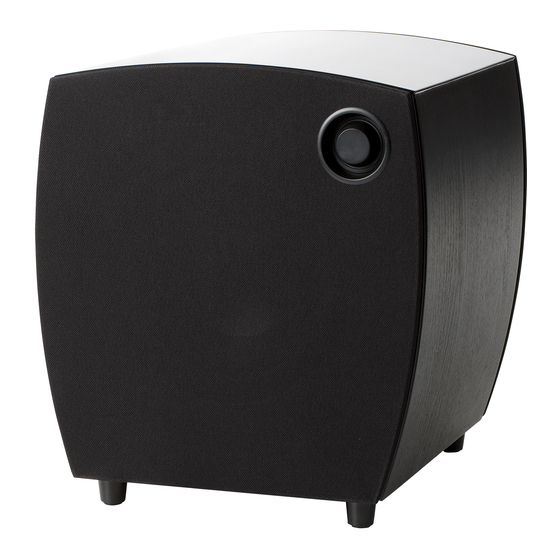JAMO C 803 브로셔 및 사양 - 페이지 7
{카테고리_이름} JAMO C 803에 대한 브로셔 및 사양을 온라인으로 검색하거나 PDF를 다운로드하세요. JAMO C 803 8 페이지. Jamo c 80 cen: product brochure
JAMO C 803에 대해서도 마찬가지입니다: 브로셔 (8 페이지), 브로셔 (19 페이지), 소유자 매뉴얼 (20 페이지)

Jamo Tech platforms
Motional Feedback (MFB)
c 80 sUB features a motional Feedback circuit. When a large woofer has been
abruptly driven by a strong sonic impulse such as an explosion or a timpani,
the woofer continues moving after the impulse stops. The mFB circuit com-
pares the impulse to be reproduced with the actual movement of the woofer.
if the woofer moves unnaturally in relation to the input signal, the mFB circuit
corrects the error before it becomes audible. Furthermore, the mFB makes it
possible to equalize the subwoofer to go deeper without losing any precision.
The result is incredibly accurate, deep bass, full of punch and dynamics.
Motional Feedback (MFB)
impulse response [V]
0
Boundary Gain Compensation
The Boundary Gain compensation filter in c 80 sUB compensates for the
room influence at low frequencies, as any room amplifies the lowest frequen-
cies. The magnitude of the room's amplification depends on the room size
and where the sub is positioned in the room – normally it increases the closer
the sub get to a wall. This can result in too high a bass level from approx.
60Hz and increasing downwards – in the range between 20 - 30Hz it peaks
up to 5 - 10dB in an average room!
at first this could sound really impressive, but the sound quickly begins to
sound 'boomy', especially when listening to music, and rather annoying. so
the Boundary Gain compensation ensures a very linear in-room bass response
and gives you more flexibility when it comes to placement and choosing your
favourite listening position.
Boundary Gain Compensation
sPL/Volts [0.33 oct]
10.0
Time - msec.
Without mFB
With mFB
off
on
100.0
Frequenzy ]Hz]
Active Impedance Control (AIC)
all c 80 mid/woofers feature active impedance control (aic), an innovative
extension of existing techniques to reduce distortion in electrodynamic loud-
speaker drivers.
The aic makes the impedance more linear in the mid and high frequency
range. aic also increases the sensitivity and total sPL in the upper range of
the driver.
AIC - Active Impedance Control:
impedance [ohm]
30
driver with aic
driver without aic
25
20
15
10
5
0
200
500
1k
The effect of aic is a clearer midrange with a markedly reduced 'roughness', es-
pecially noticeable on vocal reproduction. in figures, this amounts to a reduc-
tion of third-order harmonic distortion of around 6dB (ie a 50% reduction).
Harmonic distortion
[dB]
-35
-40
-45
-50
-55
-60
driver with aic
-65
200
500
When a voice coil is moving in and out of a magnet gap, it changes induc-
tion. When the coil moves inward, the induction increases and vice versa.
This causes the current from the amplifier to be modulated, creating very
audible distortion.
Furthermore the current flowing in the voice coil modulates the magnetiza-
tion of the magnet assembly which also causes distortion of the current.
By using an extra coil, placed inside the voice coil with opposite polarity to
the voice-coil winding, the inductance variation and the flux modulation can
be significantly counteracted.
compared to the conventional conductive rings in a magnet system aic has
the advantage that it is significantly better at higher frequencies i.e. in the
midrange (on voices) where distortion is most audible to the human ear.
Jamo C 80 page 0
2k
2k
10k
20k
Frequenzy ]Hz]
driver without aic
1k
2k
Frequenzy ]Hz]
